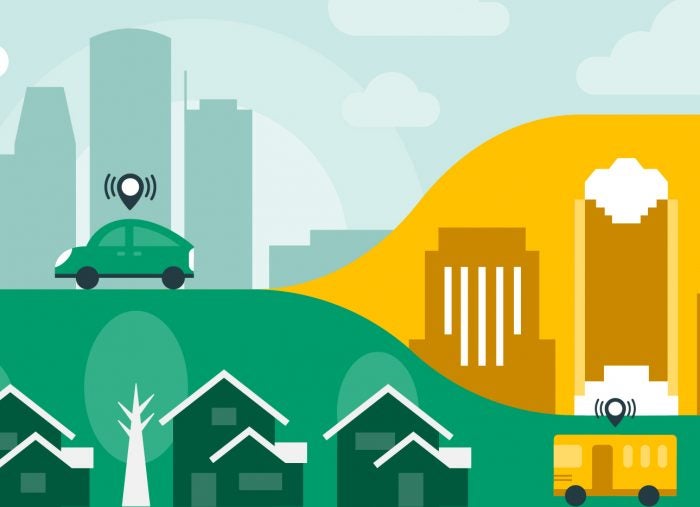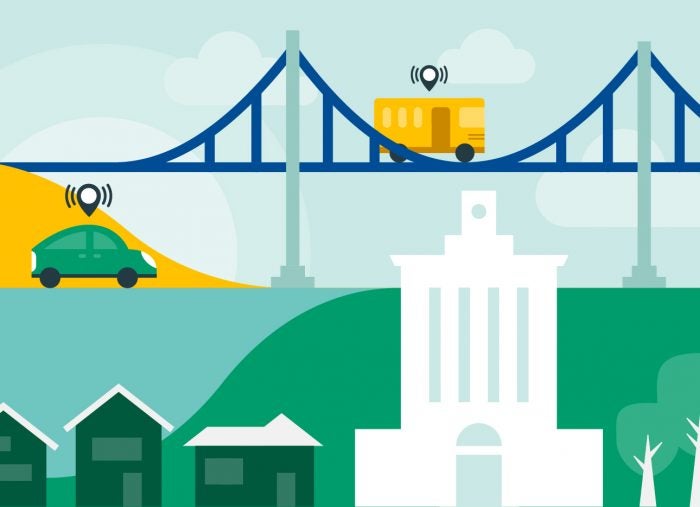Module Guide (Components)
-
Academic, Brazil, Climate, Concerned Citizen, Corporate Sustainability Professional, Energy, Environmental Justice, Government Official/Policymaker, Homepage, Monitoring, Public Health/Environmental Official, ScienceWhat’s new: At the Urban 20 Mayors (U20) Summit, Environmental Defense Fund announced the expansion of Air Tracker—its cutting-edge air quality monitoring tool—to Rio de ...
-
Academic, Community Organizer, Concerned Citizen, Corporate Sustainability Professional, Energy, Environmental Justice, Government Official/Policymaker, Homepage, Monitoring, Partners, Public Health/Environmental Official, USA
NJ state legislators and residents talk new legislation to limit warehouse and truck pollution at virtual town hall
What’s new: A coalition of environmental and community groups, including EDF, Clean Water Action and EarthJustice, held a virtual town hall last month with New ... -
Academic, Brazil, Business, China, Climate, Concerned Citizen, Corporate Sustainability Professional, Energy, Environmental Justice, Government Official/Policymaker, Homepage, India, Methane, Monitoring, Public Health/Environmental Official, Science, USA
Six ways to ramp up climate and clean air action in 2025
2024 has been a significant year for the climate and air pollution crisis, both in terms of the mounting impacts and increased action. Extreme climate ...
-
About Global Clean Air Initiative
Read MoreWith this online community, you’ll learn about how innovative technologies, scientific research and policies are supporting communities, governments and private sector leaders around the world to deliver cleaner air for all.
EDF’s Global Clean Air initiative is advancing innovation in air pollution monitoring and control around the world to tackle the growing crisis of urban air quality. Working with diverse partners on the ground in the US, Mexico, UK and China, we are advancing scientific and policy tools to support solutions that deliver cleaner air and healthier communities.
It's Time to Clear the Air
View our hyperlocal air quality mapping success stories below.
Precision data fosters meaningful change for clean air
While traditional air pollution monitoring can give us a sense of a region’s overall air quality, new sensor technologies and data analyses can pinpoint hotspots where air quality is poor, creating opportunities for both clean air advocates in the community and local governments to target their efforts addressing the problem.
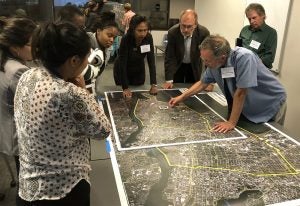
As communities gain greater insights into local pollution and its health impacts, they are taking steps to advance clean air policies. In Oakland, the West Oakland Environmental Indicators Project is leading an effort under the state’s Community Air Protection Program to reduce pollution. This community-led air improvement plan utilized air pollution, health and population data to push to limit commercial truck traffic near an area that features childcare centers, a school, a clinic and low-income housing.
See more results from the London Study
in the BL Evidence Bank
WE’RE A CREATIVE AGENCY
Sharing our data, best practices for scaling innovative air quality management globally
EDF is a leader in innovating air quality management. Our research in hyperlocal air quality monitoring has empowered local community and environmental justice leaders with the tools they need to change air pollution policy and regulations. Our efforts include members of the private sector, government officials, university researchers and corporate leaders, making this work collaborative, dynamic and impactful across a variety of sectors.
Check back here monthly as we continually add reports, how-to guides, training videos, information about webinars and more. By sharing our data, experience and expertise, we hope you’ll be empowered to create momentum for reducing air pollution where you live.
-
How-to Guide for Mapping Hyperlocal Air Pollution
Learn MoreMaking the Invisible Visible: A guide for mapping hyperlocal air pollution to drive clean air action offers information and best practices that can help leaders better understand their city’s quality challenges, how neighborhood-level monitoring can help illuminate them and how to develop a plan to significantly reduce pollution.
 A roadmap to cleaner air and healthier communities
A roadmap to cleaner air and healthier communities -
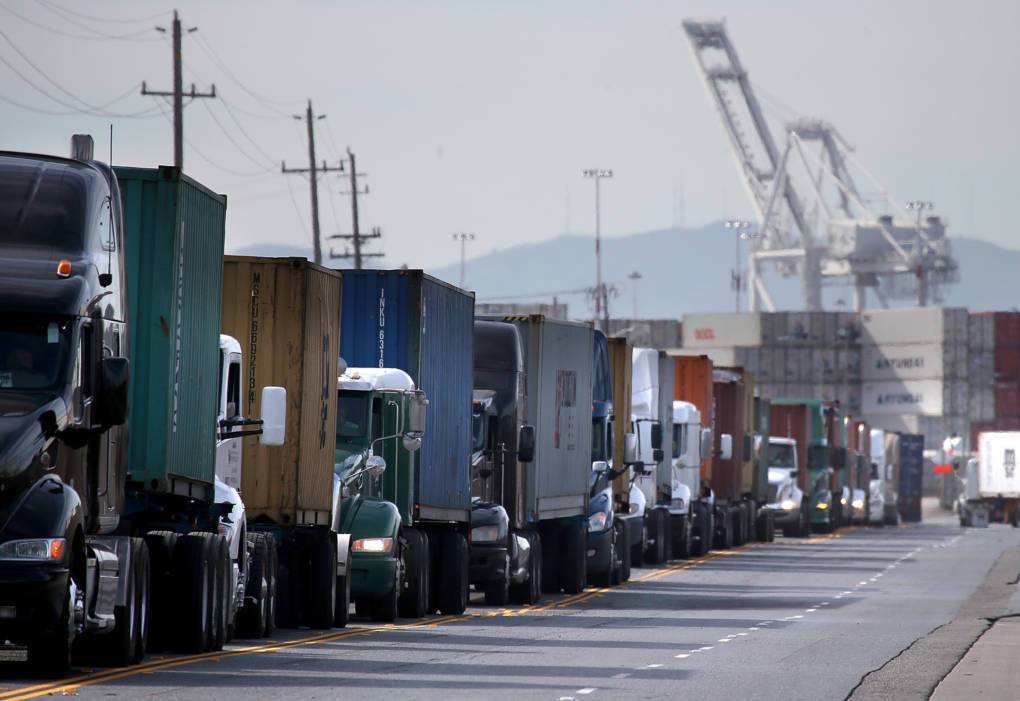 Diesel-powered freight trucks idling at Port of Oakland (Photo by Justin Sullivan via Getty Images)
Diesel-powered freight trucks idling at Port of Oakland (Photo by Justin Sullivan via Getty Images)Business Sectors
Learn MoreEDF+Business is working to create a more sustainable world where companies, communities, and the environment thrive. We’re making it happen by forging unexpected partnerships that catalyze environmental leadership and collaboration across companies and supply chains. Our team has been at the forefront of this transformation for +25 years, bringing cutting-edge science, policy, and economic expertise to high-impact companies – including McDonalds, Walmart, and KKR – to transform business as usual in their products, operations, and advocacy.
In coming months, we’ll be sharing stories here of best practices for clean air innovation in Agriculture, Aviation, Buildings, Forestry, Oil & Gas, Maritime, Transportation.
Click the button to read EDF+Business stories on clean air innovation, including stories on the need for electrification of fleet vehicles, investment opportunities for hyperlocal air quality monitoring, and more.
Resources Landing Page – Videos and Embeds
Lorem ipsum dolor sit amet, consectetur adipiscing elit libero urna, varius congue placerat egestas vulputate non nibh.
A roadmap to cleaner air and healthier communities
Mapping and measuring hyperlocal air pollution to drive clean air action
Download this How-to guide for hyperlocal monitoring.
EDF is working to share lessons learned from our on-the-ground projects so that others can use and build upon this work. Read this guide for mapping hyperlocal air pollution to drive clean air action where you live.

-
"Whether considering hyperlocal air pollution mapping or turning their air quality data into smart, local solutions, this guide meets local leaders where they are."
Scaling solutions to a global challenge
Air pollution in certain places can burden or even shorten residents’ lives:
- Global air pollution is now the biggest environmental risk of early death, responsible for as many as five million premature deaths each year. That’s more than AIDS, tuberculosis and malaria combined.
- Nine out of ten people worldwide breathe polluted air from their first breath to their last.
- Vulnerable populations are impacted the most: children, the elderly, and people with already compromised respiratory systems.
- Air pollution can be up to eight times worse on one end of a city block than another.
-

Working together for clean air
Learn MoreCities, communities and business can come together to tailor solutions for air pollution.
Watch this 8:56 video for an in-depth look at considerations for establishing an air quality monitoring network.
Harnessing data to drive action
Air pollution management typically relies on a few, sparsely located monitors. Hyperlocal monitoring can provide a more holistic picture by filling a gap in places where modeled data is not available. The result is a better understanding of how uneven pollution can be within cities. This kind of information can help cities tailor solutions that reduce pollution and deliver health and climate benefits.
Environmental Defense Fund’s guide Making the Invisible Visible: A guide for mapping hyperlocal air pollution to drive clean air action provides advice for cities, counties and other local organizations interested in using hyperlocal air quality data to drive tailored solutions for air pollution.
What the guide has to offer
The guide can help local leaders examine specific air quality challenges and research tools and introduces a suite of targeted solutions focused on investigations, emergency response, transportation and traffic, land use, and investments and incentives. It outlines how to evaluate various air quality solutions, build community awareness, and measure progress of policy decisions. It also includes case studies of work with city and community leaders that show how this new kind of data can help design new solutions, build political support for action, increase compliance, and hold polluters accountable.
-

Installing a low-cost hyperlocal air quality monitor
-

The guide empowers local leaders to take action with data
Media Contact
Natalie McKeon, (212) 616-1338 (office)
Public Health & Environmental Officials
Lorem ipsum dolor sit amet, consetetur sadipscing elitr, sed diam nonumy eirmod
Interesting in attending the next next webinar?
October 11, 2020 • Zoom
-
How-to-Guide
Learn MoreLorem ipsum dolor sit amet, consetetur sadipscing elitr, sed diam nonumy eirmod tempor invidunt ut labore et dolore magna aliquyam erat, sed diam voluptua.

-

The London Study
Learn MoreLorem ipsum dolor sit amet, consetetur sadipscing elitr, sed diam nonumy eirmod tempor invidunt ut labore et dolore magna aliquyam erat, sed diam voluptua.
-
This is a quote from a physician about how air pollution impacts the health of neighborhood residents on a hyper-local scale.
-

Health Impact Assessments
Learn MoreLorem ipsum dolor sit amet, consetetur sadipscing elitr, sed diam nonumy eirmod tempor invidunt ut labore et dolore magna aliquyam erat, sed diam voluptua.
-

Finding Pollution Sources
Learn MoreLorem ipsum dolor sit amet, consetetur sadipscing elitr, sed diam nonumy eirmod tempor invidunt ut labore et dolore magna aliquyam erat, sed diam voluptua.
-
Academic, Brazil, Climate, Concerned Citizen, Corporate Sustainability Professional, Energy, Environmental Justice, Government Official/Policymaker, Homepage, Monitoring, Public Health/Environmental Official, Science
Air Tracker expands to Rio de Janeiro, helping officials enforce air quality standards
What’s new: At the Urban 20 Mayors (U20) Summit, Environmental Defense Fund announced the expansion of Air Tracker—its cutting-edge air quality monitoring tool—to Rio de ... -
Academic, Community Organizer, Concerned Citizen, Corporate Sustainability Professional, Energy, Environmental Justice, Government Official/Policymaker, Homepage, Monitoring, Partners, Public Health/Environmental Official, USA
NJ state legislators and residents talk new legislation to limit warehouse and truck pollution at virtual town hall
What’s new: A coalition of environmental and community groups, including EDF, Clean Water Action and EarthJustice, held a virtual town hall last month with New ... -
Academic, Brazil, Business, China, Climate, Concerned Citizen, Corporate Sustainability Professional, Energy, Environmental Justice, Government Official/Policymaker, Homepage, India, Methane, Monitoring, Public Health/Environmental Official, Science, USA
Six ways to ramp up climate and clean air action in 2025
2024 has been a significant year for the climate and air pollution crisis, both in terms of the mounting impacts and increased action. Extreme climate ...
Latest Updates
Air Tracker expands to Rio de Janeiro, helping officials enforce air quality standards
Latest Blog Posts
-
Academic, Brazil, Climate, Concerned Citizen, Corporate Sustainability Professional, Energy, Environmental Justice, Government Official/Policymaker, Homepage, Monitoring, Public Health/Environmental Official, Science
Air Tracker expands to Rio de Janeiro, helping officials enforce air quality standards
What’s new: At the Urban 20 Mayors (U20) Summit, Environmental Defense Fund announced the expansion of Air Tracker—its cutting-edge air quality monitoring tool—to Rio de ... -
-
-
Latest News
-
Event: Unleashing clean air funding for climate and health benefits at LAC Climate Week 2023
Join us in-person or virtually for a Latin America and the Caribbean Climate Week Side Event: “Unleashing clean air funding for climate and health benefits” ... -
-
-
Latest Press Releases
-
Community Organizer, Concerned Citizen, Environmental Justice, Government Official/Policymaker, Monitoring, Partners, Public Health/Environmental Official, USA
New report: At least 1 in 6 Illinois residents lives within a half mile of a mega-warehouse
(SPRINGFIELD, IL – April 23, 2024) A new report released Wednesday, April 24 by the Environmental Defense Fund traces the growth of mega-warehouses in Illinois ... -
Academic, Climate, Community Organizer, Concerned Citizen, Energy, Environmental Justice, Government Official/Policymaker, Homepage, Monitoring, Public Health/Environmental Official, Science, Texas, USA
New Study quantifies health impacts from oil and gas flaring in the U.S.
A new study led by researchers at the University of North Carolina at Chapel Hill Institute for the Environment, Boston University School of Public Health and the ... -
Climate, Concerned Citizen, Environmental Justice, Government Official/Policymaker, Homepage, Monitoring, Public Health/Environmental Official, Science, USA
MethaneSAT is Launching Today on Groundbreaking Mission to Protect the Climate
First satellite developed by an environmental non-profit will see methane emissions others can’t, paving the way for heightened accountability and faster reductions (VANDENBERG SFB, LOMPOC ... -
Concerned Citizen, Environmental Justice, Government Official/Policymaker, Public Health/Environmental Official, Science, USA
New Analysis: EPA Clean Vehicle Standards Will Save Thousands of Lives, Protect Health, Slash Air Pollution
(Washington, D.C. – February 28, 2024) The Environmental Protection Agency’s proposed pollution standards for new cars, buses and freight trucks would save more than 40,000 ... -
EPA and DOE Announce $1 Billion in Funding for Methane Mitigation
EPA and DOE took critical action today in announcing the availability of $1 billion in funding from Congress’s Methane Emissions Reduction Program (passed as part of the ... -
EPA acts to protect millions of Americans from soot pollution
(Washington, D.C. – February 7, 2024) The Environmental Protection Agency today announced an updated, stronger national health standard for particulate matter – a potentially deadly ... -
Report launch: 1 in 4 New York residents lives within a half mile of a mega-warehouse
FOR IMMEDIATE RELEASE (ALBANY – January 15, 2024) A new report to be released January 18 by Environmental Defense Fund (EDF) and ElectrifyNY traces the ... -
Appeals Court Again Denies Industry Attempts to Halt Good Neighbor Clean Air Plan
(Washington, D.C. – October 11, 2023) The U.S. Court of Appeals for the D.C. Circuit today rejected another attempt by industrial polluters to halt the ... -
New Proposal Would Expand Air Quality Monitoring
Technology Assessment for Air Quality Management Act Will Protect Public Health June 20, 2023 WASHINGTON, D.C. — Today Senator Ed Markey (D-MA), Representative Lisa Blunt ... -
Proposed Consent Decree Addresses EPA’s Failure to Modernize National Pollution Limits for Gas-Burning Power Plants
(June 13, 2023 – Washington, D.C.) – Today, EPA published notice of a proposed consent decree requiring the agency to review and, if appropriate, revise Clean ... -
New research from Environmental Defense Fund Inc. finds smog intensifying in Northern India
Satellite data shows links between meteorology and particulate emissions from urban and rural areas, that warm the lower atmosphere, points to opportunities to reduce widespread ... -
U.S. Agency for International Development, Clean Air Catalyst and Indore Municipal Corporation Launch New Air Quality Monitoring Stations
New state-of-the-art equipment to provide data on sources of local air pollution (INDORE, February 15, 2023) The U.S. Agency for International Development (USAID), Clean Air ... -
EPA’s Important Initiative to Protect People from Soot Pollution Should be Further Strengthened to Save Lives
(Washington, D.C. – January 6, 2022) The U.S. Environmental Protection Agency is taking an important step toward strengthening our nation’s health-based standards for particle or ... -
$53m in New Funding for Community-level Air Quality Monitoring Projects to Support Local Efforts to Measure Air Pollution
Today, the U.S. Environmental Protection Agency (EPA) announced $53 million in funding for air quality monitoring for communities throughout the U.S., the largest such investment ... -
Una nueva alianza para mejorar la calidad del aire, promover la salud mundial y los objetivos climáticos en países de América Latina y el Caribe
PARA SU PUBLICACIÓN INMEDIATA Contacto: Lexi Ambrogi, (973) 960-0073, lambrogi@edf.org Una nueva alianza para mejorar la calidad del aire, promover la salud mundial y los ... -
Nova parceria para melhorar a qualidade do ar e avançar com as metas globais climáticas e de saúde em países da América Latina e do Caribe
PARA PUBLICAÇÃO IMEDIATA Contacto: Lexi Ambrogi, (973) 960-0073, lambrogi@edf.org Nova parceria para melhorar a qualidade do ar e avançar com as metas globais climáticas e ... -
New Partnership to Improve Air Quality, Advance Global Health and Climate Goals in Latin American and Caribbean Countries
A new partnership announced today between the United Nations Environment Programme (UNEP) and Environmental Defense Fund (EDF) will build collaborative clean air solutions in 33 ... -
California Approves Clean Cars Standards, Speeds Toward a Future Free from Tailpipe Pollution
The California Air Resources Board just approved new standards that will ensure all new cars and passenger trucks sold in the state will be zero-emitting ... -
STUDY: New Research Links Higher Street-Level Traffic-Related Air Pollution with Increased Emergency Room Costs
(Washington, D.C. – August 9, 2022) A new study published in the journal Atmospheric Environment finds that long-term exposure to traffic-related air pollution is associated with higher ... -
McEachin Bill Would Provide Tools to Protect Health Through Better Understanding of Local Air Pollution
(Washington, D.C. – July 28, 2022) U.S. Representative A. Donald McEachin (VA) today introduced the “Technology Assessment for Air Quality Management Act” to strengthen hyperlocal ... -
Bill Would Protect Public Health with Better Air Pollution Data
(Washington, D.C. – July 13, 2022) U.S. Rep. Lisa Blunt Rochester (D-DE) and Sen. Tammy Duckworth (D-IL) today reintroduced the Public Health Air Quality Act of ... -
EDF “Strongly Supports” Proposal to Strengthen Cross-State Air Pollution Rule, Protect Millions from Smog-Forming Coal-Plant Smokestack Pollution
(Washington, D.C. – June 22, 2022) Environmental Defense Fund is urging EPA to update and strengthen the Cross-State Air Pollution Rule in order to protect ... -
New Tool Shows Air Pollution’s Path
(HOUSTON, TX) Environmental Defense Fund today unveiled Air Tracker, a first-of-its-kind web-based tool that allows users to plot the likely path of air pollution. Run on ... -
REPORT: For Senior Populations, Black Americans Are Three Times More Likely to Die from Exposure to Particle Pollution Than White Americans
(Washington, D.C. – June 3, 2022) Black Americans 65 and older are three times more likely to die from exposure to fine particle air pollution ... -
Strengthening EPA Standards to Include Zero-Emitting Freight Trucks and Buses Critical for Reaching Health, Climate Goals – EDF Expert at EPA Public Hearing
Statement from EDF legal fellow Andy Su: “Deploying zero-emitting heavy-duty vehicles is critical to reach our health and climate goals. We urge EPA to move ... -
New US Fuel Economy Standards Will Clean Air, Save Americans Money, Strengthen National Security
(Washington, D.C. – April 1, 2022) The U.S. Department of Transportation’s National Highway Traffic Safety Administration (NHTSA) announced today final standards that will improve fuel ... -
EPA Proposes Pollution Standards for Freight Trucks and Buses
Statement from Peter Zalzal: “Heavy-duty vehicles like freight trucks, delivery vans, transit buses and school buses are a significant source of both climate pollution and ... -
EDF, Allies Move to Defend EPA in Legal Challenges to Clean Car Standards
Statement from Alice Henderson, Senior Attorney and Director of Transportation and Clean Air Policy: “These clean car standards will deliver enormous climate and public health ... -
Leading Environmental Groups Respond to Attacks Against Clean Air Act Heard Before Supreme Court
Statement from EDF President Fred Krupp: “Coal companies and their allies asked the Supreme Court today to prevent the EPA from limiting the huge amount ... -
Castor, Blunt Rochester, Torres Air Quality Monitoring Bill is a Step Toward Helping Communities Tackle Longstanding Inequities
Statement by Heather McTeer Toney: “While there is a long way to go to address the systemic injustices associated with infrastructure development in this country, ... -
New Study Finds Rapidly Declining Costs for Zero-Emitting Freight Trucks and Buses
Statement by Peter Zalzal: “Pollution from freight trucks and buses is dangerous to people’s health and accelerates climate change. This study finds that zero-emitting solutions ... -
EPA Science Advisory Committee Draft Letter Recommends EPA Strengthen Particulate Pollution Standard
Statement by EDF Analyst Taylor Bacon: “CASAC’s draft letter provides additional, strong support for EPA’s decision to revisit our national health-based standards for particulate pollution. ... -
EPA Takes Welcome Step to Support Mercury and Air Toxics Standards, Protect Americans from Dangerous Pollution from Coal-Fired Power Plants
Statement by EDF Lead Counsel Michael Panfil: “Today, EPA released its proposed finding that is it ‘appropriate and necessary’ under the Clean Air Act to ... -
Environmental Protection Agency to Step Up Enforcement and Monitoring of Pollution in Overburdened Communities
Statement by Heather McTeer Toney: “The Environmental Protection Agency today took a significant step on the march toward justice for communities that it for too ... -
Markey Bill Provides Tools to Better Understand Local Sources of Air Pollution and Protect Health
Statement by Sarah Vogel: “Hyperlocal air quality monitoring technologies are critically important for understanding the local health impacts of air pollution. We need better data ... -
Protective Clean Car Standards Will Reduce Pollution, Save Money, Be a Gift to All Americans
Statement by Fred Krupp: “Today EPA announced the most protective clean car standards our nation has ever adopted to address the climate crisis. The standards are ... -
EDF: Colo. Governor Budget Proposal Makes Strong Air Quality Investments, But Doesn’t Make Up for Delayed Action on Pollution
EDF Statement by Alex DeGolia, Director, U.S. Climate (Boulder, CO – November 4, 2021) On November 1st, the Polis administration released its budget proposal for ... -
Saving Lives Must Be Prioritized: Updated WHO Global Air Quality Guidelines Must Transform Data into Action for All
EDF Statement by Sergio Sánchez, Sept 22, 2021 “The World Health Organization’s update of the global Air Quality Guidelines is an important step forward. Based ... -
Environmental Justice Air Quality Monitoring Act Step Toward Helping Communities Tackle Longstanding Inequities
“Every community should live free of the burden of harmful air pollution. With the introduction of the Environmental Justice Air Quality Monitoring Act, Senator Markey ... -
U.S. Must Do More to Eliminate Tailpipe Pollution from Cars, Trucks and SUVs
“If news reports are correct, our nation must do more than focus on the Trump rollbacks alone to swiftly eliminate tailpipe pollution from new passenger ... -
New Interactive Map Has Details about Power Plants that Are the Source of Smog-Forming NOx Pollution
Environmental Defense Fund, Moms Clean Air Force, and M.J. Bradley & Associates today unveiled a new interactive map with detailed information about the fossil fuel-fired ... -
EDF, Allies Give EPA Robust Support for Restoring Unlawfully Withdrawn State Clean Car Waiver
Environmental Defense Fund and 11 other public interest groups have filed comments with the Environmental Protection Agency detailing the reasons why the agency should rescind ... -
Bipartisan Climate and Health Win: House Votes to Reinstate Oil & Gas Pollution Rules; Methane Emissions Resolution now Moves on to the White House
With bipartisan support, the U.S. House of Representatives voted to restore EPA rules limiting oil and gas methane pollution from new wells, processing plants and ... -
Senators Whitehouse and Schatz Introduce Bill to Cut Climate and Air Pollution Across the Economy and Invest in Communities
Senators Sheldon Whitehouse (D-RI) and Brian Schatz (D-HI) introduced the Save Our Future Act today, which would assess a fee on carbon dioxide and criteria ... -
EDF, Allies Strongly Support EPA Revoking Trump-Era Rule that Distorted Benefits of Clean Air Protections
EDF joined nine other public interest organizations this week to support EPA’s efforts to undo a Trump-era rule that left millions of Americans at greater ... -
EDF Files Clean Cars Comments, As Enthusiasm for Zero-Emission Vehicles Picks Up Speed
(June 11, 2021) EDF filed comments in two matters related to clean vehicles today, as the momentum for increased deployment of zero-emission cars, trucks and ... -
EPA Will Consider Strengthening Particle Pollution Standards
Statement of EDF Senior Attorney Rachel Fullmer – June 10, 2021 “EPA’s announcement today that it will reconsider strengthening our protections against particle pollution is a ... -
EDF Successfully Co-Hosts Beijing “Workshop on Blue Sky and Low Carbon Actions Empowered by New Technologies” and Launches Carbon Neutrality Challenge
(BEIJING May 24, 2021) On April 27, 2021, EDF co-hosted the “Workshop on Blue Sky and Low Carbon Actions Empowered by New Technologies” in Beijing ... -
EPA Repeals Rule That Distorted Benefits of Life-Saving Clean Air Protections
(Washington, D.C. – May 13, 2021) EPA is eliminating a harmful Trump-era rule that would have made it harder to protect Americans from air pollution ... -
New Study Finds California’s Zero-Emission Cars Standards Could Save Lives, Reduce Pollution, Save Californians Money
(May 4, 2021) California could save more than 7,000 lives by 2050, significantly reduce smog and climate pollution, and save new car buyers thousands of ... -
New study reveals large and unequal health burden from air pollution in California’s Bay Area
(Washington, D.C. – March 31, 2021) New research published today in the journal Environmental Health Perspectives from Environmental Defense Fund and George Washington University shows air ... -
Coalition Calls for Biden Administration to Adopt Clean Air Standards that Eliminate Pollution from Freight Trucks
(Washington, D.C. – March 24, 2021) Seventeen business, equity, science, clean energy, faith and environmental groups are publicly calling on the Biden administration to set ... -
EPA Takes a “Good Step” for Public Health with Update to Cross-State Air Pollution Rule
(Washington, D.C. – March 16, 2021) The U.S. Environmental Protection Agency just took a valuable step toward protecting millions of people in downwind states from ... -
New Report Finds Clean Trucks and Buses Will Save Thousands of Lives, Slash Air Pollution, Create Jobs
(Washington, D.C. – March 4, 2021) Air pollution standards that ensure all new heavy-duty trucks and buses sold for urban and community use are zero-emitting ... -
Millions of Pounds of Air Pollution Released Because of Grid Failure, Freeze in Texas
(Houston, TX – February 23, 2021) Oil refineries, petrochemical plants and other unprepared industrial facilities in Texas reported releasing an estimated 3.5 million of pounds ... -
EDF report introduces innovative financing model to accelerate adoption of zero-emissions vehicles
(New York, N.Y – February 17, 2021) Environmental Defense Fund (EDF) today published a report on how companies can transition their shipping from fossil-fuel powered delivery ... -
EDF Hails Biden’s Bold Push to Confront the Climate Crisis while Strengthening the Economy and Addressing Injustice
Statement from Fred Krupp, President, Environmental Defense Fund (NEW YORK – Jan. 27, 2021) President Joe Biden took significant action today to combat the climate ... -
Two New Reports Confirm the Dramatic Benefits of Zero Emitting Vehicles – More Jobs, Less Pollution, Consumer Savings
(Washington, D.C. – January 26, 2021) Two new reports that Environmental Defense Fund has released or commissioned show the significant opportunity that clean cars have ... -
Trump EPA Idling on Aviation Air Pollution
(WASHINGTON-Dec 28, 2020) On December 23, 2020, the Environmental Protection Agency Administrator signed EPA’s Rule on Greenhouse Gas Emissions from Aircraft. While that rule acknowledges the ... -
Trump Administration Gives Americans a Holiday “Gift” of More Smog
(WASHINGTON–Dec 23, 2020) “Tens of millions of Americans live in an area with unhealthy levels of smog, and today’s decision by the Trump administration to ... -
Air Pollution as Cause of Young Girl’s Death Underscores Need for Urgent Action
(LONDON–December 16, 2020) An inquest into the cause of 9-year old Ella Roberta Adoo Kissi-Debrah’s death concluded today, with the ruling that dangerously high levels ... -
Trump Administration Decision on Soot Standard Exposes Americans to Dangerous Air Pollution
(Washington, D.C. – December 7, 2020) Today, during its final weeks in office, the Trump administration finalized a decision to leave an inadequate standard for ... -
Four Leading Environmental and Science Groups Call on Automakers to Support Clean Car Standards
(WASHINGTON– December 2, 2020) The leaders of four of America’s largest and most influential environmental and science organizations – Environmental Defense Fund, Natural Resources Defense ... -
EDF Launches “Power Up, America” Campaign
(WASHINGTON- November 30, 2020) A push to reduce air pollution, create jobs and healthy communities by building electric trucks, buses, cars and clean power.
-
New Multi-Agency Effort Aims to Reduce Air Pollution, Disaster Risk in Houston
(Houston – September 28, 2020) To streamline how the Houston region responds to hazardous air pollution, the city of Houston, Harris County and Environmental Defense ... -
Traffic congestion increasing in London above 2019 levels outside city centre
(London–Sept 15, 2020) A new analysis by Environmental Defense Fund Europe (EDF Europe), based on data from the Waze for Cities Programme, shows that traffic ... -
Clean air innovation initiative launched by Mexican Authorities and Environmental Defense Fund
(Mexico City– Sept. 7, 2020) A new collaboration effort aimed to harness the transformative power of new technologies to give people knowledge for tackling air ... -
Public Health Air Quality Act Would Protect Public Health with Better Air Pollution Data for All
(Washington, D.C. – July 29, 2020) Today a bicameral group of Members of Congress introduced the Public Health Air Quality Act of 2020, a bill ... -
New EDF Guide: Mapping Hyperlocal Air Quality to Drive Clean Air Action
(COPENHAGEN, Denmark – Oct. 9, 2019) Environmental Defense Fund released a guide for cities, counties and other local organizations interested in using hyperlocal air quality ... -
Study: Street-level air pollution increases health risk among elderly
A new study published today in the journal Environmental Health shows that differences in traffic-related air pollution are associated with higher rates of heart attacks and deaths from heart ... -
Study: Urban Air Pollution Varies from Block to Block
(June 5, 2017) An article published today in the journal Environmental Science and Technology demonstrates how a new approach to measuring air quality reveals pollution patterns at far greater ...
Sign-up for our Newsletter
[wpforms id=”198″]
Global Clean Air blog
Our flagship blog features insights from our staff experts around the world, written for a general audience.
-
Academic, Brazil, Climate, Concerned Citizen, Corporate Sustainability Professional, Energy, Environmental Justice, Government Official/Policymaker, Homepage, Monitoring, Public Health/Environmental Official, Science
Air Tracker expands to Rio de Janeiro, helping officials enforce air quality standards
What’s new: At the Urban 20 Mayors (U20) Summit, Environmental Defense Fund announced the expansion of Air Tracker—its cutting-edge air quality monitoring tool—to Rio de ... -
Academic, Community Organizer, Concerned Citizen, Corporate Sustainability Professional, Energy, Environmental Justice, Government Official/Policymaker, Homepage, Monitoring, Partners, Public Health/Environmental Official, USA
NJ state legislators and residents talk new legislation to limit warehouse and truck pollution at virtual town hall
What’s new: A coalition of environmental and community groups, including EDF, Clean Water Action and EarthJustice, held a virtual town hall last month with New ... -
Academic, Brazil, Business, China, Climate, Concerned Citizen, Corporate Sustainability Professional, Energy, Environmental Justice, Government Official/Policymaker, Homepage, India, Methane, Monitoring, Public Health/Environmental Official, Science, USA
Six ways to ramp up climate and clean air action in 2025
2024 has been a significant year for the climate and air pollution crisis, both in terms of the mounting impacts and increased action. Extreme climate ... -
Academic, Climate, Environmental Justice, Government Official/Policymaker, Homepage, Methane, Mexico, Monitoring, New York City, Public Health/Environmental Official, USA
Sarah Vogel highlights health benefits of cutting methane at Health Forum during UN General Assembly
What’s new: Foreign Policy magazine hosted a Health Forum during the UN General Assembly last month in New York, where EDF’s Sarah Vogel explained how ... -
Academic, Energy, Environmental Justice, Government Official/Policymaker, Homepage, Mexico, Monitoring, Public Health/Environmental Official, Science
Cutting methane benefits health: EDF and partners set action-oriented research agenda in Mexico
What’s New: Earlier this month, Environmental Defense Fund (EDF) and the Observatorio Mexicano de Emisiones de Metano (ObMEM) hosted a seminar-workshop to co-create a research ... -
Academic, Brazil, China, Climate, Environmental Justice, Government Official/Policymaker, Homepage, Public Health/Environmental Official, Science, USA
New #WorldCleanAirDay podcast: How we’re adapting Air Tracker in the U.S., China and soon Brazil
On September 7, for the 5th International Day of Clean Air for Blue Skies, EDF is highlighting how our cutting-edge tools are advancing the fight ... -
Academic, Community Organizer, Concerned Citizen, Corporate Sustainability Professional, Energy, Environmental Justice, Government Official/Policymaker, Homepage, Monitoring, Partners, Public Health/Environmental Official, USA
New Air Quality Data Directory connects advocates with crucial data to advance clean air goals
By Adrienne Parks, Analyst, Community Engagement What’s new: A new tool from Environmental Defense Fund and partners is making it easier to connect clean air ... -
Academic, Brazil, Climate, Community Organizer, Concerned Citizen, Energy, Environmental Justice, Government Official/Policymaker, Homepage, Public Health/Environmental Official, Science
EDF team visits Brazil to expand Air Tracker, support clean air action
What’s new: Our recent trip to Brazil in June gave EDF the opportunity to formalize partnerships with city and state officials in Rio de Janeiro ... -
Academic, Business, Climate, Community Organizer, Concerned Citizen, Energy, Environmental Justice, Government Official/Policymaker, Homepage, Monitoring, New York City, Partners, Public Health/Environmental Official, USA
Video: EDF and partners release report finding one in three New Jersey residents lives near a mega-warehouse
What’s new: EDF released a new report tracing the growth of mega-warehouses and associated diesel truck pollution in New Jersey, building upon recent research in New ... -
Academic, Business, Climate, Concerned Citizen, Corporate Sustainability Professional, Energy, Environmental Justice, Government Official/Policymaker, Homepage, Monitoring, Public Health/Environmental Official, Science
New State of Global Air report shows pollution’s deadly impact
What’s new: The Health Effects Institute’s new State of Global Air 2024 report finds that air pollution ranks as the second leading risk factor for ...
Houston Study
Finding pollution—and who it impacts most—in Houston
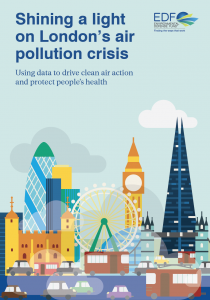
Monitoring air quality is a critical step toward reducing pollution, but data on its own doesn’t necessarily lead to healthier communities.
Using measured and modelled datasets from the ambitious Breathe London pilot project, as well as other London data, we have produced analyses that spotlight the capital’s pollution problem. We’ve examined when and where pollution is worst – as well as who is most impacted – and highlighted specific policies that can address pollution sources.
By making data actionable, we aim to inspire targeted policy action so all Londoners can breathe easier.
Explore our London pollution data stories below, or see here for a full list of analyses.
Houston Study (Case Study) – Image

-
"EDF’s work on clean air enhances awareness and advocacy in environmental justice communities. Recent projects focused on community air monitoring enable residents, as well as public health and elected officials, to begin to understand and address ongoing and emerging air quality issues. Education has been valuable for increasing awareness related to air quality and clean air efforts."
Metal recycling and concrete batch plants—which produce cancer-causing particulate air toxics—are also magnets for heavy duty vehicles. Diesel-fueled vehicles within the heavy-duty fleet emit black carbon and NOx into many of Houston’s residential neighborhoods.
Our researchers found pollution levels similar to the areas near highways at one third of these facilities within the neighborhoods we sampled.
These results demonstrate how the city’s lack of zoning places some of Houston’s most vulnerable people in the path of harmful pollution. In fact, nearly a third (29%) of the area’s concrete batch plants and more than half (51%) of the area’s metal recycling facilities are located within a half mile of at least one school or childcare center.
Nearly half of Houston’s schools face elevated pollution
By mapping our air quality data alongside the locations of schools, local pollution sources, and sociodemographic information, we can better understand not only where pollution is at its worst but who that pollution impacts.

We found that even children whose schools aren’t near major industrial facilities could face elevated pollution levels. Our researchers measured nitrogen dioxide (NO2) levels above the typical citywide levels outside nearly half (46%) of the schools and childcare centers we monitored. This can have a profound impact on children’s health. Exposure to nitrogen oxides (NO and NO2) can result in the development and exacerbations of asthma and bronchitis.
Explore our interactive maps
We drove more than 32,000 miles. Here’s what we found.
MAP!!!
Click on the map above to see average pollution levels in London.
There is an invisible threat to Londoners’ health: Air pollution likely contributes to thousands of early deaths in London every year.
Urban residents need better information on pollution’s health effects, as well as readily available — and understandable — air pollution data and analysis. That’s why the Breathe London pilot project mapped and measured pollution across the capital, led for two years by Environmental Defense Fund Europe and launched in partnership with the Mayor of London and leading science and technology experts.
With more than 100 lower-cost sensor pods and specially-equipped Google Street View cars, Breathe London complemented and expanded upon London’s existing monitoring networks. The project aimed to help people better understand their local air quality and support cities around the world with future monitoring initiatives. EDF developed the Breathe London Blueprint for global cities, which includes both a guide for city-level decision-makers and a more detailed Technical Report.



